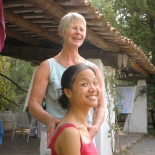Tips4Teachers – Thought, energy and the atlanto-occipital joint
The physical aspect of “head forward and up” I have written about in another post (see Tips4Teachers – Head Forward and Up).
Here I want to discuss the way in which the freedom of the atlanto-occipital joint and the tone of the sub-occipital muscles are intricately connected with mental and emotional states.
The point at which the base of the skull sits on the atlas can be thought of as not only the physical connection between head and spine, but also the place where mind and body interface; a two-way flow of information and feedback.
Sensitive hands can detect subtle energies flowing through this area. These energies relate to and are influenced by mental and emotional processes.
In order to allow energies to flow freely, one has to, as Patrick Macdonald put it:
“….learn to get out of ITS way.” 1
The “it” cannot be exactly defined, but we can discover what needs to let go in order to get out of the way.
At this level of work it is not about releasing muscle tension; it is about the “something” that generates the tension. We could call it a mental or emotional state, an attitude or even a belief. At the core however, it is a sense of ‘self’ sustained by a collection of personality traits and their associated sensory habits; “It feels like this to be me!”
The teacher is advised to explore the process of ‘getting out of the way’ outside of the teaching room in his or her daily life, otherwise even this most subtle aspect of hands-on work can become seeking out states or experiences for their own sake.
Nevertheless, when a moment of “getting out of the way” is facilitated through a multi-level interaction with the pupil, it is transformative:
“The old accumulations of subconscious thought are dispersed, and room is made for new conceptions and realizations.” 2
This, provided it is not confined to the rarefied atmosphere of the teaching room but is ventured in the reality of Life. is the most difficult, most challenging but ultimately most rewarding aspect of Alexander’s teaching, It can be scary, exhilarating, liberating; it is the unknown.
To paraphrase Lennon and McCartney:
“What do you see when you get out of ITS way?
I can’t tell you, but I know it’s mine.”
1. The Alexander Technique As I See It, Patrick MacDonald; Notebook Jottings. Published by Rahula Books, 1989 (back to text).
2. Man’s Supreme Inheritance, FM Alexander; Notes and Instances (back to text).
© John Hunter 2014




Recent Comments